Home Theater Speaker Placement—Where Do I Put My Speakers?
Getting a loudspeaker system is just the beginning. Once you get everything home, you still need to set up your speakers for the best possible listening experience. It’s this accurate home theater speaker placement that separates the truly dedicated from the amateurs. Others have written extensive articles detailing every possible way to configure a room full of speakers. Rather than go down that path, I will simplify things a bit to make it more palatable for the masses. After all, I’m not trying to give you a degree in sound reinforcement, just give you a leg up in home theater speaker placement for your living space that approximates the surround sound you experience in the theater.
And that’s what we’re really going for here—to get as close to that theatrical experience as possible. But there are huge differences in loudspeaker placement when you compare home theater speaker placement against a movie theater. For one, home theaters tend to be more reflective in their acoustical properties. A movie theater is designed to be almost completely “dead”. Nearly all of the sound you hear in a theater is coming from the speakers. In the home, the room plays an important role.
You also have a lot more speakers in a movie theater, often with several surround speakers along both the side and back of the room. And the front and center speakers are located behind a perforated screen so that the sound emanates completely from the on-screen action. While this is possible in home theater that uses a front projection system, it’s often not practical to place speakers behind a screen. The good news for you is that most people can move speakers around a room without much trouble or even having to break out the cordless power tools. Plus, if you’re still in the setup stage, you can try out several locations to find one that’s right for you before you do a final install.
Getting Started—How Many Speakers Are You Using?
Whether you’re planning your home theater, or you have already purchased speakers, a big question is: How many speakers are you placing in the room? This is a basic starting point, but it will allow you to jump down to the appropriate part of this article to fit your particular application. You may want to read through the whole thing, however, as we do explain ways to configure your system so that it’s ready for a potential future upgrade. You may also want to see our article on Upgrading Your Speakers Hassle-free for tips on when and how to go from one configuration to another.
Stereo Two-channel Speaker Placement
The most basic audio system is a stereo system. But that doesn’t mean you can just throw speakers into a room and expect great sound. For one, there is an audio characteristic called “imaging” that deals with how the stereo separation is perceived by the listener. This also affects the “soundstage” which is how you can locate individual sounds within the stereo image. A good soundstage will let you, for example, point out where the cellist is sitting when listening to a live recording of a quartet.
You affect both soundstage and imaging by a combination of the distance between the speakers, the distance from the speakers to the listener, and the angle at which the speakers are “toed-in” or pointed at the center listening position. We can help with the initial layout, however, we recommend you experiment with loudspeaker toe-in to get the best sound. Some speakers do better pointed nearly straight ahead, perpendicular to the rear wall, while others want to be pointed nearly directly at the center “hot” seat. Backing up, here are some recommendations for setting up stereo speakers in a room:
Start by setting up your front speakers so that you form a triangle with the primary (center) listening position. Make sure you give your speakers enough room between them that they can create a nice stereo image. Lots of times we see people place their speakers directly to the right and left of their television. While this may meet the aesthetic requirements of your spouse, a 42-inch or 50-inch television is not going to provide enough stereo separation for your music to sound good, nor will it allow for movies to have that expansive theatrical sound.
Once you get the distance and positioning correct, experiment with the toe-in of the speakers. Start with the speakers only slightly toed-in (angled towards the center seated position) and play back a piece of music you are familiar with—preferably a live track so you can attempt to ascertain the location of various performers on stage. After listening for a bit, get up and slightly increase the angle of the speakers, always moving them further inward. Listen again. The point at which you can hear the widest, most expansive sound and most accurately “pinpoint” musicians where they are playing on the stage is the correct amount of toe-in for your speakers.
5.1 Surround Home Theater Speaker Placement for Movies
The nice thing about adding more speakers is that you build upon what you’ve already done. For example, expanding a stereo system into 5.1 surround doesn’t require you to re-position the front speakers—unless you upgrade. With 5.1 there are two basic home theater speaker placement configurations: the recommended configuration and the “drop back and punt” configuration. It’s not that the second configuration is awful, but it’s not what will best reproduce 5.1 surround as it was mixed. In either case, here is the standard method of configuring a room for 5.1 surround:
In a typical 5.1 surround placement you will want to place your surround speakers to the side and just behind the listening position. Often, these speakers are diffuse speakers, called “dipole” speakers. The reason for this is that, for movies, surround speakers are meant to be ambient-supplying sources for effects and backgrounds, with the occasional point-source effect.
If you can’t place your speakers to the side, then an alternate rear-wall placement is a great secondary option. With this home theater speaker placement, be sure not to point the rear speakers towards the listening position—at least not if your goal is to configure the system for primarily movie-watching. Here is what that style of speaker layout might look like:
5.1 Surround Speaker Placement for Music
For multi-channel music you keep almost the same configuration as the 5.1 surround layout above, however you want speakers that are not diffuse. These can be two-way bookshelf speakers, or even another matched pair of tower speakers. These surrounds will be separated by at least 60 degrees or more and angled inward towards the center listening seat.
With this type of loudspeaker arrangement, you will get a rich and full surround experience when listening to SACDs, DVD-Audio discs, or any Blu-ray concert DVD that has multi-channel audio. Above all, you want to try and place the seating area equidistant from all of the speakers. That’s not to say that you can’t do this if you simply must have your rear speakers closer to you than your fronts, but ideally, this is the arrangement. If you do need to position your speakers differently, use your AV receiver’s distance and level settings to calibrate your system so that all playback levels are the same.
7.1 Surround Speaker Placement
7.1 is great if you have some room behind your listening position. Many living spaces can accommodate this, but it takes a room that’s long enough for the extra speakers to be worth it. We would assert that if your room doesn’t easily support a 7.1 system, you’re better off upgrading your 5.1 speakers over adding a couple more and trying to make it work. With 7.1 there are actually two schools of thought for placement of home theater speakers. If you have a THX-certified AV receiver, you can use the ASA (Advanced Speaker Array) DSP to enable some very impressive surround sound. The way it works is to place two speakers nearly side-by-side at the rear of the room, with the rest of the room configured as you would with a regular 5.1 surround sound system. These rear speakers will then interact with the side surrounds to deliver accurate or diffuse surrounds based on the mode and the content being played back. THX has designed this to be flexible enough to handle all of the required surround formats and they recommend it when used in conjunction with equipment that has their particular digital signal processing (THX-certified AV receivers).
If you don’t have a THX receiver, then you may want to set up your room for standard Dolby TrueHD and DTS Master Audio playback. This is a similar layout, except that the rear speakers are placed roughly 60 degrees apart on the rear wall.
Exceptions to the Rule and Alternate Placement Options
Not everyone has the same size or shape room. And, of course, not everyone has the same speakers. With surround sound you get a lot of flexibility, but you do want to adhere to as many of the “rules” as possible. Here are a few to try and stick to whenever possible:
- Try to keep your speakers parallel with each other. Your surrounds should both be the same distance back from the front of the room as opposed to having one be closer to the television than another.
- Avoid in-ceiling main or center-channel speakers when possible. You want the sound to come from the screen/television and elevated speakers tend to take the action away from the screen.
- Placing a subwoofer in a corner, though popular, results in more “peaky” uneven bass response. Try and put your sub at least a few feet away from a corner whenever possible. This is a general suggestion and so we recommend using our Where Do I Place My Subwoofer guide to find the best spot for your subwoofer.
- Di-pole surround speakers create a nice diffuse sound for soundtracks while bi-pole speakers offer more direct sound. Some surround speakers can switch in-between both modes. While this isn’t terribly convenient, it may offer you some more flexibility if you’re on the fence as to whether you listen more to movies or music in multi-channel surround sound.
- Try not to sit against a rear wall. If you can even move your seat or sofa a foot or two away from the rear wall it will help eliminate acoustical problems associated with being up against a boundary wall.
- Always level match your speakers after you adjust them in any way—whether you move them, or toe them in or change out any equipment.
Conclusion
Speaker placement could be an exact science, were it not for the fact that hardly anyone has the perfect room! Do you best and, above all, experiment! Half the fun of setting up and configuring a surround sound speaker system is getting to tweak it until you get the best possible sound—and that means watching lots of movies and listening to lots of music. It’s like going fishing—if you have the right attitude you know the process is going to be fun no matter what the result. So tweak, and tweak, and tweak some more. When you get it right, you’ll know.
Do you have a 5.1 listening room or a 7.1 listening room? We want to know. Leave us a comment below and join in the discussion.

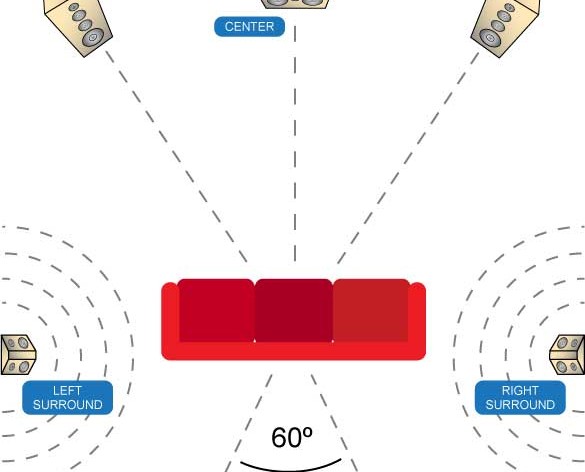
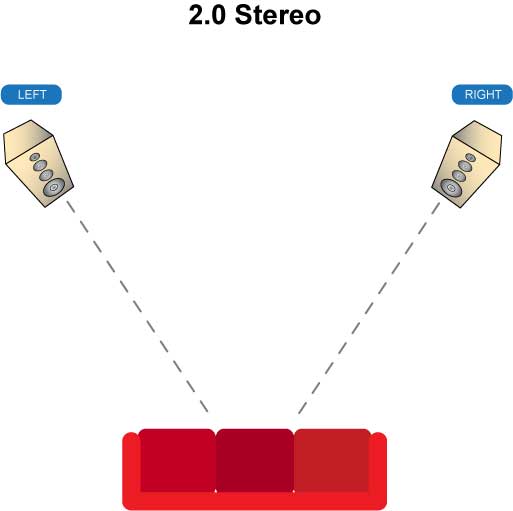

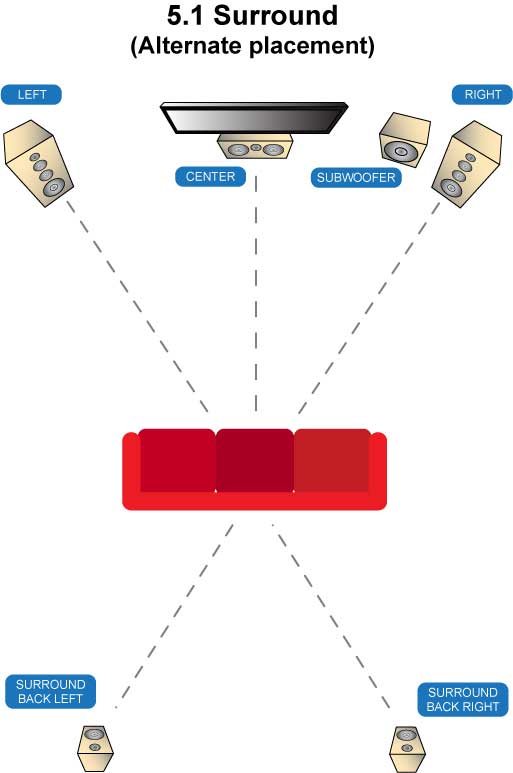
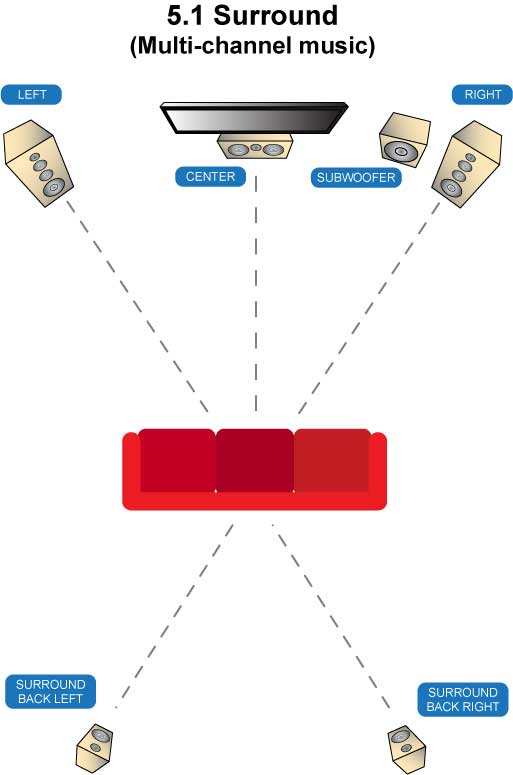

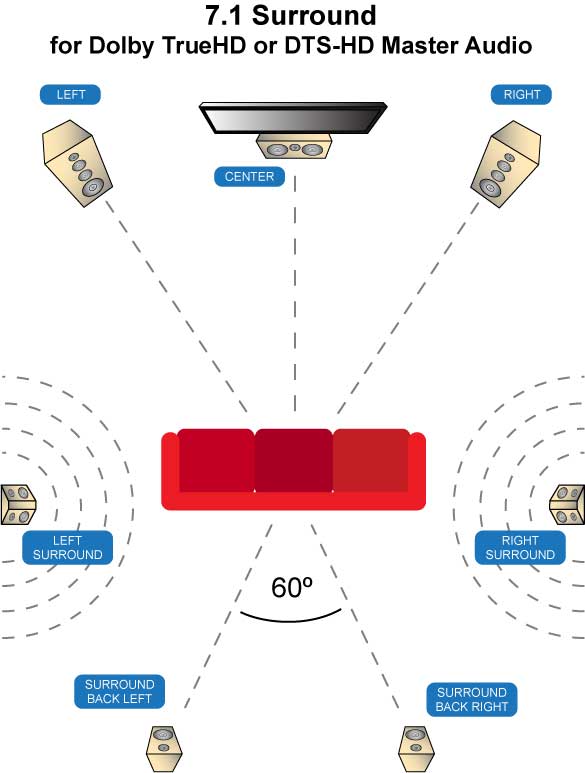
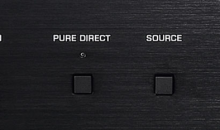
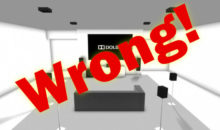



Thanks for all the tips. I need more!!! I have a receiver that has 7.1 however my media room has is large and my couch is tall, so I have little options for placing the rear speakers directly behind the couch. I have lots of speakers but not sure where to add them. i am currently running 5.1 but wanting to go 7.1 But I may have to get very creative. Please advise
You’ll want elevated speakers (wall-mounted) if you have a high-back couch. Also, you only want to go with 7.1, if you have room (at least 2-3 feet) behind your couch.
Hi
My room is 12×10 so quite small but couch is more than two feet away from rear wall so can do 7.1.
Question is surround speakers will be close to the ears as eventually want to have atmos 7.1.4 setup but wondered if it would be to much for a small room with surrounds being close to listening position so would a 5.1.4 setup be better?.
This situation hasn’t been an issue before as the speakers were mounted a few feet above listening position so 7.1’sounded fine but atmos states surround speakers should be ear height to gain effect from ceiling speakers bringing them much closer to the listener!
12 x 10 might get very overwhelmed by 7.1.4 or even 5.1.4. When you jam too many speakers into a smaller area you can get a lot of audio collisions due to the room acoustics. I might suggest trying 5.1.2 and spending a higher dollar amount on the speakers themselves, rather than spreading your dollars thinner on a higher quantity of speakers. Does that make sense?
Hello, I have a 24 x 12 foot room and I will be running a 7.1 system. Have exactly three feet between back wall and couch with a large window directly behind the couch. Looking for best placement for back surrounds. Was thinking above window centered on the wall. Speakers would be approx. 8 feet from the floor just below the ceiling. Using in wall speakers for all 7 channels. Struggling with how far apart the speakers should be spaced apart. Lastly, was going to place center channel in wall under 65″ mounted tv. This would place the speaker approx. 3″ from the floor. Any advice is greatly appreciated.
Hi Clint, great article. I dont have space behind my couch. Would you recommend wall mounted dipoles behind the couch? Mounting them on the side walls is not really an option due to the configuration of the room. I’d be sticking with 5.1.
The link i provided is an example of the layout of the living room i created using lazyboy’s virtual room creator.
You can do dipoles, or you can mount small bookshelf speakers and face them towards each other for a more diffuse sound behind you. It’s a bit more difficult when the couch is directly against the wall. You don’t want the sound directly in your ears or otherwise aimed at your head.
Hi Clint. I am adding rear surround speakers to upgrade from a 5.1 to 7.1. in my 20 x 22′ family room. My ‘rear wall’ is the face of a soffit above an open kitchen behind my family room. This necessitates either in-wall or in-ceiling speakers for the rears. At best the in-wall speakers would be about 10′ above the floor and about 4′ behind my listening position. I would use speakers with aimable tweeters. The ceiling is 13′ high so that is how high ceiling speakers would be. What do you think about in-wall vs. in-ceiling speakers?
If I understand you correctly, I’d probably go with in-wall (spaced maybe 8-9 feet apart at most) as the surround back speakers are meant to be more directional (called point source) than diffuse. I’d be worried that you’d just get a “wash” of sound (or a distraction) from the 13′ in-ceiling position.
You have described placement for movies and music, but what about 3D gaming? Will the 5.1 alternate layout or 5.1 music layout work better?
Hi! My sofa is just infront of the rear wall. Im using dipole speakers and they are mounted on the side. It is mounted probably 1 feet away from the rear wall in order to be adjacent to the listener. Will the sound quality be affected? If so, are there any possible resolutions to solve this? Maybe some acoustic panels on the rear wall? Will be greatly looking forward to your advice. Thanks in advance!
I have Klipsch RP 240S for my side speakers in a 7.2 set up. My wife doesn’t want my sides level with our heads at sitting level in fear someone will knock them off. I called Klipsch. They do not make an in wall speaker with same capabilities. Would it hurt to mount those same speakers just higher on the wall?
Hi,
I too am looking into a 7.2.1 system. Two speakers in back, two on the side, two speakers in front, and one center speaker. Then there are two subwoofers, one on each side. Maybe extra bass from the two subwoofers is too much. Really need to go and see what is available!
Hi. Great article. How high should the speakers be? In particular I have a 120″ projection screen and I would like to know how high relative to the screen should I put the front speakers? What about the center speaker, should I place it above or below the screen? For the rear speakers I have the choice of mounting them at any height on the side walls. Any suggestions?
Hi Clint thanks for your article. We are finishing our basement in the next few months and I need to decide on placement of my in-wall speakers. The front channels and sub are already figured out. It’s the surround that needs attention.
Because of the shape of the room, my left/right side walls are very far away and different distances to the couch. This presents a problem with typical 5.1 surround speaker in-wall placement (as I do not want speaker stands on either side of the couch). Your alternate placement 5.1 diagram solves this issue by moving the speakers into the back wall and assigning them as rear surround channels. However, I feel this may compromise too much and I’m wondering your thoughts on putting the center surrounds in the ceiling and adding rear surrounds to the back wall for a 7.1 layout instead of your alternate 5.1 layout. Would that work better?
I know the center surrounds are supposed to be above the listener, so I’m thinking if we added a pair of in-ceiling dipole surround speakers for the L and R center surround and add an additional pair of speakers rear surround speakers in the back wall @ Dolby 60 degrees (go with a 7.1 system) would it create a better surround environment? Basically, a traditional Dolby 7.1 location but with surrounds 5′ above the listener in the ceiling firing downwards? To add further complication, how would this play nice or not nice with a 7.1.4 atmos setup (6 speakers in the ceiling, 2 surrounds and 4 atmos)?
Hi Clint,
I have 4 ceiling and 1 center wall speaker plus a subwoofer. Is it okay to place the center under the projection screen? If so where do I place the 4 ceiling speakers? Thanks
what is the ideal position of 5.1 speakers for a 246 in. x 125 in. room? the sofa’s at the foot of the bed measuring about 8 ft in lenght…. btw the tv’s at the far end of the room… thanks in advance
Hello — I have a question about spacing of the rear surrounds vs the side surrounds? I currently have all 5.1 with all ceiling speakers. My new receiver can handle 7.1 and I have a 20 x 21 living room with an open floor plan to the kitchen behind. I removed plywood from attic above and I have a choice of putting the rear surround speakers 2 1/2 ft or 4 ft behind the surrounds and inward half the distance apart. Would you go 2 1/2 or 4 ft back on the distance between the side surrounds and the rear surrounds? I can’t go any farther back as their are recessed can lights at 6″ back.
Hello. I am setting up a 5.1.4 system. In inchs, how far from the front of the sofa, and the back should I put my celling speakers. It doesn’t have to be perfect. But there must be some kind of general inches between most set up’s. Thank you
We are adding a room to our house that is approx. 27 X 26. About 700 sq ft. with this being a new build I am open to put my speakers wherever I want before the drywall is added. I am looking to do in wall speakers. Would you recommend 5.1 or 7.1 and how would you set up the speakers?
With a room that large, I’d do 7.1 and possibly Dolby Atmos ceiling speakers.
I’m building the audio portion of our new great room home theater which is 36 X 40. Projector and screen already installed. It is in a log lodge with 12ft. walls an open vaulted ceiling with log trusses on 12′ centers at the top of the walls. On one end of the building we have a prow with a 12′ fireplace in the middle and a 12′ set of doors on either side of it. We don’t want to have any kind of center speaker in front of the fireplace so a would like to use two center speakers on either side of the fireplace hearth ( also subwoofer ) rather than on the mantle and the L & R fronts on the other side of the doors 18′ off center. I originally had planned set it up across the room and therefore didn’t prewire for these speakers. I have two questions: I though I could use Klipsch wireless for the center(s) and the front L& R ( or other quality wireless ) and then use the hardwiring I have in place for the balance of a 9.2.4 atmos system. In talking with some other vendors and techs they say that will not work as they will be a sync problem between the wired and wireless units? They also say that a total wireless 9.2.4 system is not available but I think with the size of the room I need that for the best sound quality. Like you recommendation on speakers as well and on what to use for the atmos units which would have to be in enclosures and be mounted on the overhead log trusses. I was planning on a Denon AVR X 6300H to drive the system as I’ve had excellent luck with the Denon equipment I have owned over the years. Thanks for your help and please let me know if this is too much to ask of you?
Hi l have a 5.1 speakers in a bed room- l have a double bed with posts- the front -one foot high-the rear posts two feet high-can the speakers be placed on these posts to get theatre sound the centre speaker been placed in between the front post speakers on a rail- another idea is hang them from the ceiling by wire so they are suspended above my bed- any ideas for or against or advice would be greatly appreciated-thanks
hi clint…!!!
I’m Antonis and I’m from Greece and I have a question.
I have 9.2 setup, a THX-certified AV receiver (Pioneer SC-LX57) & a THX-certified 7.2 speakers Crystal Acoustics T3-7.2-UL ( http://www.crystalaudio.com/eur/crystal-acoustics-t3-7-2-ul-7-2-reference-home-theatre-system.html ) and front Speakers height Crystal Acoustics TX-B1 ( http://www.crystalaudio.com/eur/speakers/speakers-bookshelf/speakers-bookshelf-tx-bookshelf.html )
The rear speakers they are also Dipole Surrounds ,what distance will be placed on the rear wall?
Thank you very much…!!!
I’ll be building a new house soon. My front speakers will be in a cabinet. My wife does not want rear speakers in the walls. The couch will be against the rear wall I think. Will it be OK to put speakers in a 9 ft. ceiling and exactly where should they be. It will be a 5.1 system.
Hi. I have a 14 ft into 20 ft room where i wanna install 7.1.
is it possible to install the the two Surround Back Speakers under the ceiling. How do i get optimum performance.thanks.